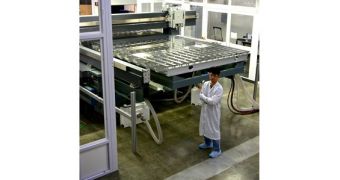Many flexible displays have been released over the years, but none of them has been used in actual devices yet, mostly because none of the prototypes had the minimum degree of endurance. This may change by the end of 2014 though.
You'd probably expect the final breakthrough to come from the labs of Samsung, LG, Panasonic, or some other world-class display developer and vendor.
That is not the case here, exactly. Instead, a startup company called Kateeva, from Menlo Park, California, has introduced a flexible display technology that will fulfill those dreams.
What Kateeva did was create an inkjet printing process that applies a protective coating to OLEDs (organic light-emitting diodes) at a much greater speed than other methods. This cuts manufacturing costs in half and makes it possible to integrate the techniques in existing production lines easily.
More importantly, though, Kateeva has figured out how to compensate for the greatest disadvantage of Indium tin oxide (ITO), the transparent, conductive material used in touch displays.
ITO cracks. Normally, it maintains integrity, but when you bend the screen it crumbles. It's just that brittle, much as we wished it wasn't. It's why all the curved OLEDs and LCDs are fixed.
There's an alternative though, provided by a company based in Helsinki, Finland: thin films covered in a network of carbon nanobuds (nanotubes with spheres of carbon attached to them). Kateeva is one of the companies that has been practically applying these materials.
The key is the ability of the carbon nanobuds to stretch and curve around a radius of as little as a millimeter. Kateeva expects to ship manufacturing equipment capable of producing flexible touch panels by the end of 2014.
Unfortunately, we don't have a more exact ETA than that (estimated time of arrival). Kateeva doesn't have plans of joining the display industry itself, you see, so it's likelier that the big names we mentioned before, Samsung, LG etc., will place orders for its fabrication equipment instead.
Between the orders, the shipment times, and the weeks it will take to integrate the inkjet printing process in the companies' factories, availability will probably come no sooner than December, provided it happens this year at all. Christmas shipments of bendable phones would be cool, no doubt, but there's still a chance that mass shipments won't start before 2015.
Greg Raupp, an expert on display technology at Arizona State University, theorizes that the first flexible displays will still have a limit to how much they can actually bend or fold. Panels that can roll probably won't be launched from the get-go.

 14 DAY TRIAL //
14 DAY TRIAL //